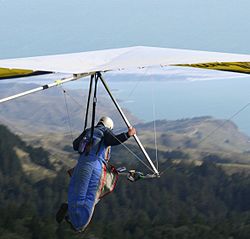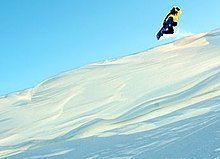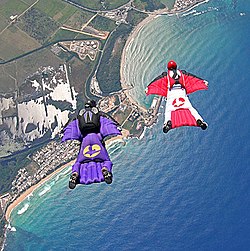Extreme sport: Difference between revisions
Vertigo900 (talk | contribs) m Text edit. |
Vertigo900 (talk | contribs) m Added a photo to the page. Added a section. Added text. |
||
| Line 32: | Line 32: | ||
[[Image:Hanggliding03042006.JPG|250px|thumb|[[Hang glider]] launching from [[Mount Tamalpais]]]] |
[[Image:Hanggliding03042006.JPG|250px|thumb|[[Hang glider]] launching from [[Mount Tamalpais]]]] |
||
| ⚫ | The definition of extreme sports may have shifted over the years due to marketing trends. When the term first surfaced circa the late 1980s/early 1990s, it was used for adult sports such as [[skydiving]], [[scuba diving]], [[surfing]], [[rock climbing]], [[snow skiing]], [[water skiing]], [[snowboarding]], [[mountain biking]], [[mountaineering]], [[cave exploration]], [[storm chasing]], [[hang gliding]], and [[bungee jumping]], many of which were undergoing an unprecedented growth in popularity at the time. [[Outside (magazine)|Outside magazine]], not the X Games, epitomized the meaning of the term, and if there was a clothing style associated with extreme sports it was an "outdoorsy" look favoring brand names associated with mountaineering or backpacking such as The North Face and Patagonia, Teva sandals or hiking boots for footwear, etc. The term nowadays applies more to youth sports like skateboarding, snowboarding, and BMX and is closely associated with marketing efforts aimed at the younger generation (e.g. the ad campaigns of [[Mountain Dew]]), and with their favored styles of clothing and music, especially the kind of urban baggy look associated with skateboarders, and loud, fast alternative rock. This shift in styles may also be partly a generational shift, as [[Baby Boomers]] and [[Generation X]] have aged and marketing efforts associated with extreme sports shifted toward the younger [[Generation Y]] demographic sometime in the mid to late 1990s.[[Image:Snowboarder cornice at sugarbowl.jpg|right|thumb|Snowboarder drops off a [[cornice]] at Sugar Bowl Ski Resort]] |
||
[[Image:Snowboarder cornice at sugarbowl.jpg|right|thumb|Snowboarder drops off a [[cornice]] at Sugar Bowl Ski Resort]] |
|||
| ⚫ | The definition of extreme sports may have shifted over the years due to marketing trends. When the term first surfaced circa the late 1980s/early 1990s, it was used for adult sports such as [[skydiving]], [[scuba diving]], [[surfing]], [[rock climbing]], [[snow skiing]], [[water skiing]], [[snowboarding]], [[mountain biking]], [[mountaineering]], [[cave exploration]], [[storm chasing]], [[hang gliding]], and [[bungee jumping]], many of which were undergoing an unprecedented growth in popularity at the time. [[Outside (magazine)|Outside magazine]], not the X Games, epitomized the meaning of the term, and if there was a clothing style associated with extreme sports it was an "outdoorsy" look favoring brand names associated with mountaineering or backpacking such as The North Face and Patagonia, Teva sandals or hiking boots for footwear, etc. The term nowadays applies more to youth sports like skateboarding, snowboarding, and BMX and is closely associated with marketing efforts aimed at the younger generation (e.g. the ad campaigns of [[Mountain Dew]]), and with their favored styles of clothing and music, especially the kind of urban baggy look associated with skateboarders, and loud, fast alternative rock. This shift in styles may also be partly a generational shift, as [[Baby Boomers]] and [[Generation X]] have aged and marketing efforts associated with extreme sports shifted toward the younger [[Generation Y]] demographic sometime in the mid to late 1990s. |
||
[[Image:Wingsuit-01.jpg|250px|thumb|[[Wingsuit flying]] is a relatively new extreme sport.]] |
[[Image:Wingsuit-01.jpg|250px|thumb|[[Wingsuit flying]] is a relatively new extreme sport.]] |
||
Revision as of 23:54, 31 March 2008
Extreme sport (also called action sport and adventure sport) is a media term for certain activities perceived as having a high level of inherent danger.[1][2] These actives often involve speed, height, high level of physical exertion, high specialized gear or spectacular stunts.[1]
At present date, there are no careful studies or statistics of deaths to separate activities with low or normal level of danger from those with high level of danger. Therefore is not even possible to categorize activities as extreme sports and the term is often used for the marketing.

Overview

Extreme sports differ from standard sports due to the relatively higher number of inherently uncontrollable variables in extreme sports. Extreme sport athletes compete not only against other athletes, but also against environmental obstacles and challenges. These environmental variables are frequently weather and terrain related, including wind, snow, water and mountains. Because these natural phenomena cannot be controlled, they inevitably affect the outcome of the given sport or event.
In a standard sporting event, athletes compete against each other under controlled circumstances. While it is possible to create a controlled extreme sporting event, there are often variables that cannot be held constant for all athletes. Examples include snow conditions for snowboarders, rock and ice quality for climbers, and wave height for surfers.
Marketing
Some contend[citation needed] that the distinction between an extreme sport and a conventional one is as much to do with marketing as it is to do with perceptions about levels of danger involved or the amount of adrenaline generated. Furthermore a sport like rugby union, though dangerous and adrenaline-inducing, would not fall into the category of extreme sports due to its traditional image, and it does not have certain things that other extreme sports do, such as very high level of speed and an intention to perform stunts. Scuba diving is not seen as an extreme sport these days, despite the level of danger and physical exertion, because of its primarily adult demographic. Also the fact that it is not classed as a sport, as there is no objective to the activity. Another example: compare the perception of demolition derby, not usually thought of as an extreme sport, to that of BMX racing, which is. Demolition derby has an adult demographic, BMX is a youth sport.

The definition of extreme sports may have shifted over the years due to marketing trends. When the term first surfaced circa the late 1980s/early 1990s, it was used for adult sports such as skydiving, scuba diving, surfing, rock climbing, snow skiing, water skiing, snowboarding, mountain biking, mountaineering, cave exploration, storm chasing, hang gliding, and bungee jumping, many of which were undergoing an unprecedented growth in popularity at the time. Outside magazine, not the X Games, epitomized the meaning of the term, and if there was a clothing style associated with extreme sports it was an "outdoorsy" look favoring brand names associated with mountaineering or backpacking such as The North Face and Patagonia, Teva sandals or hiking boots for footwear, etc. The term nowadays applies more to youth sports like skateboarding, snowboarding, and BMX and is closely associated with marketing efforts aimed at the younger generation (e.g. the ad campaigns of Mountain Dew), and with their favored styles of clothing and music, especially the kind of urban baggy look associated with skateboarders, and loud, fast alternative rock. This shift in styles may also be partly a generational shift, as Baby Boomers and Generation X have aged and marketing efforts associated with extreme sports shifted toward the younger Generation Y demographic sometime in the mid to late 1990s.


The term gained popularity with the advent of the X Games, a made-for-television collection of events. Advertisers were quick to recognize the appeal of the event to the public, as a consequence competitors and organizers are not wanting for sponsorship these days. The high profile of extreme sports and the culture surrounding them has also led people to invent parodies, such as Extreme ironing, urban housework, extreme croquet, and house gymnastics.
The difference between the serious extreme sports and imitation or parody is not always obvious.
Adrenaline rush
A feature of such activities in the view of some is their alleged capacity to induce an adrenaline rush in participants. However, the medical view is that the rush or high associated with the activity is not due to adrenaline being released as a response to fear, but due to increased levels of dopamine, endorphins and serotonin because of the high level of physical exertion.[citation needed] Furthermore, a recent study suggests that the link to adrenaline and 'true' extreme sports is tentative.[3] The study defined 'true' extreme sports as a leisure or recreation activity where the most likely outcome of a mismanaged accident or mistake was death. This definition was designed to separate the marketing hype from the activity. Another characteristic of activities so labeled is they tend to be individual rather than team sports. Extreme sports can include both competitive and non-competitive activities.
Reasons

Some who enjoy extreme sports repudiate the stereotypical "adrenaline junkie" tag. The practitioners would claim they enjoy developing their physical and/or mental skills, seek mastery of inhospitable environments, look to escape from the mundane rigors of day-to-day existence, or simply love the wilderness environment in which many of these sports take place. Bob Drury, a paraglider pilot says, "We do these things not to escape life, but to prevent life escaping us"—even though accidents in these sports could be fatal. Many participants also don't think of their activities as either extreme or sports at all. To the most passionate purists, the sport label doesn't fit because they aren't competing to win anything. Worse, the extreme label has frequently been blamed for stereotyping participants in these activities as stupid, reckless, and even suicidal. Eric Brymer PhD (2005) [4] also found that the potential of various extraordinary human experiences, many of which parallel those found in activities such as meditation, was an important part of the extreme sport experience.
Some of the sports have existed for decades and their proponents span generations, some going on to become well known personalities. Rock climbing and ice climbing have spawned publicly recognizable names such as Edmund Hillary, Chris Bonington, Wolfgang Gullich and more recently Joe Simpson. Another example is surfing, which was originally invented centuries ago by the native inhabitants of Hawaii.
See also
References
- ^ a b Webster's New Millennium™ Dictionary of English, Preview Edition (v 0.9.7). extreme sport - definition. Dictionary.com. Retrieved 2007-06-11.
Extreme sports feature a combination of speed, height, danger and spectacular stunts.
{{cite book}}: CS1 maint: numeric names: authors list (link) - ^ The American Heritage® Dictionary of the English Language, Fourth Edition by Houghton Mifflin Company. (2006). extreme - definition. Dictionary.com. Retrieved 2008-03-05.
6. Sports: a. Very dangerous or difficult: extreme rafting. b. Participating or tending to participate in a very dangerous or difficult sport: an extreme skier.
- ^ Brymer, Eric and Gray, Tonia PhD, Extreme Sports: A Challenge to Phenomenology. University of Wollongong, Australia, 2004
- ^ Brymer, Eric PHD, Extreme Dude: A Phenomenological Perspective on the Extreme sports experience . University of Wollongong, Australia, 2005
